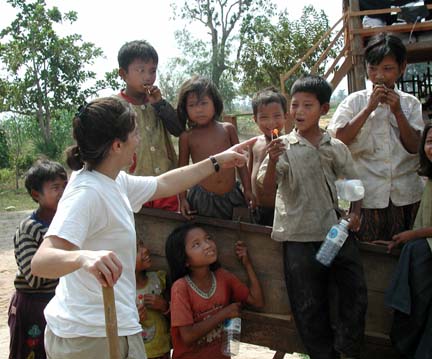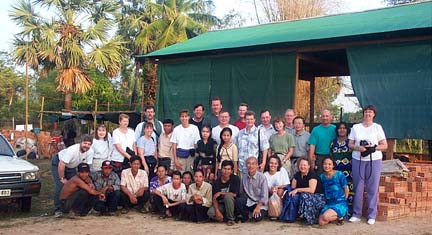Reprinted with permission from
HIGHLANDS RANCH HERALD
March 8, 2001
Ranch
residents lend helping hand in Cambodia
By
TAMRA MONAHAN
STAFF
WRITER
For a group of parishioners at St. Luke’s Methodist Church in Highlands Ranch, the new year brought with it a new experience.
Twenty members of the church spent two weeks in January in rural Cambodia helping to build a community center. The group, consisting of 10 men and 10 women, traveled half-way across the world as part of a missionary trip sponsored by the church.
This was the second trip of this kind for St. Luke’s Church. The first was in 1997 to Zimbabwe, Africa where church members helped build a grain mill structure for an orphanage.
The Cambodia trip was to help Cambodian refugees, Joseph Chan and his wife Marilyn, build a community center for people in rural Cambodia. Chan and his wife fled the country when the Khmer Rouge came to power in the early 1970s, and have since returned to their homeland to help their countrymen.
The Chans had a dream of creating a community center which would give adults and older children agricultural and vocational skills to help them better their lives. They also hope to have a clinic at the center to bring much needed medical care to the Cambodian people.
Although the community center will educate those who attend classes, Chan had to be careful in the way he set up the center’s programming. In no way could the center’s mission be construed as educating the people of Cambodia because the country is still somewhat under the Khmer Rouge regime which is known for slaughtering millions of educated Cambodians in the 1970s and 80s. Instead, Chan’s center gives rural Cambodians training to help them become better farmers or tradesmen.
When they decided to take this missionary trip, the Highlands Ranch residents entered a country with a government distrustful of foreigners, especially ones with education. This is a government which has systematically destroyed the literate population of its country, and educated Americans came to build a training center designed to help the illiterate become trained, skilled workers.
It was a dangerous undertaking, but none of the missionaries were in fear for their lives. They had armed guards surrounding their camp at all times and felt comfortable with the people in the nearby villages and towns. The desire to help the people of Cambodia who have so much less than the poorest Americans outweighed any concerns they had.
“In the preparation for going on this trip, people would say, Why are you going to Cambodia?’ And I would say, I am supposed to,”’ said St. Luke’s parishioner Linda Harris.
Others in the group also felt a calling to go, even with the inherent dangers.
However, one of their biggest fears was traveling half-way across the world and living with 20 people that they barely knew for two weeks. Would they all get along? Would they get on each other’s nerves? How could they depend on each other in unknown situations when they didn’t even know one another?
But their trepidations quickly subsided in light of the goal they had to accomplish. The group quickly evolved into a tight-knit family unit, sharing experiences, fears, sorrows, joys and lots of love for each other and their fellow Cambodians who worked on the project and took care of the group.
The Americans worked side by side with Cambodian men preparing the soil, laying bricks, cutting wood, framing the structure and any other tasks necessary to build the community center.
At first, the Cambodians were surprised to see Americans perform manual labor because up to this time, they had only encountered tourists who wanted to take pictures. They stared in amazement as Brian Sorsby, the group’s construction expert, showed everyone how to build a brick wall.
Then the most amazing thing happened — the American women actually began working with the men laying brick, cutting wood and lifting heavy pieces of lumber.
In rural Cambodia, society has a definite hierarchy with distinct designations for male and female jobs. The men farm, build and perform tasks necessary to keep the village going. The women cook, clean and wash the clothes from sunup to sundown. Therefore, to see women working in traditional male jobs was startling to the Cambodians, but they soon came to accept the situation and enjoyed watching the Americans and working with them.
As a token of their appreciation to the Americans, the village women cooked all their meals and washed their clothes, never allowing the Americans to help. It would have been an insult to have their guests assist with meals or other mundane chores. The missionary group said it was somewhat uncomfortable being waited on, but they soon learned to appreciate the Cambodians’ generosity.
They did, however, return the gesture on the last night of their stay by waiting on the villagers at a ceremonial dinner. Although their intentions were well-meaning, the group's actions had some funny and dire consequences because of the language and cultural barrier.
One mistake they made was asking the local mayor to take communion, which was difficult since he is Buddhist.
The next problem arose when the group served dinner to everyone in attendance, including Buddhist monks who were fasting. At first, the Americans could not understand why the men would not try the food, assuring them it was very tasty. Finally, a Cambodian who speaks English explained that the monks could not eat because they were in the midst of a religious fast.
Language was probably the biggest hurdle the group had to overcome with the Cambodians. One of the Americans, Rich Boon, learned a few phrases before leaving the United States, but for the most part they didn’t speak Khmer, nor did most of the Cambodians speak English. When there was no interpreter around, the Americans used smiles, hand gestures and pictures to communicate with their fellow workers.
Most of the time this was fine, but occasionally there were incidents of miscommunication.
Joyce Carnes said she was amazed how well the group communicated with the Cambodian children without using language. The Americans played soccer and other games with the children. Both adults and children expressed their feelings through eye contact, gestures and laughter, breaking down barriers in a matter of minutes.
“I think it was amazing how well we got
along with the children without knowing their language,” she said. “They were
very open, and they would come every afternoon, and we would play with them.
There were particular people in the group that just had a way of communicating
with the children.”
One of these was group member Dan Raap. Everyone agreed that Raap was the undisputed favorite with the children. He has a magnetic smile that draws people to him, and his wonderful laugh made the Cambodian children giggle. They would imitate Raap’s laughter because it was so loud and different from anything they had heard before.
Raap himself was different from anything the Cambodians had ever seen. With a height of more than 6 feet, he towered over Cambodian adults and looked like a giant to the children. He created quite a stir in the nearby town and at one point had a group of older women standing behind him staring and gawking at the tallest man they had ever encountered.
“I had the biggest tummy for miles around, and I also learned, after a couple of days, why people would come up and rub my tummy for good luck,” he said. “I was probably the tallest man in Cambodia.”
Despite the scorching heat (reaching upwards of 130 degrees Fahrenheit), the gigantic scorpions, the breakfast of boiled chicken feet and back-breaking work, these 20 Highlands Ranch residents were sorry to leave so soon and would return in a heartbeat. They fell in love with the Cambodian people, culture and food. They enjoyed seeing a country closed to the western world for many years. They created lifelong friendships with Joseph and Marilyn Chan and all the people who helped build the community center.
But most of all, they renewed their faith by giving unselfishly to other human beings who are in need.
If the call comes again for a group of people to lend a hand somewhere in the world, they will be the first in line.
St. Luke’s will host a spaghetti dinner and movie night at the church March 30 to show a video of the Cambodian Mission. Everyone is welcome.

St. Luke's missionary Marla Vasten shows Cambodian children the wonders of suckers. These kids had never experienced the western world treat, and they loved it.

St. Luke’s Methodist Church Cambodian missionaries: Dale Balu, Rich Boon, Joyce
Carnes, Nita Dunn, Rev. Richard Evans, Ken Fong, Marie Fornof, Laurie Gilbert, Linda
Harris, Debbie Lawrence, Andrea Mezger, Esther Miyahara-Cho, Mark Moore, Steve
Plain, Dan Raap, Steve Riley, Brian Sorsby, Sharon Stonecipher, Marla and Brett Vasten.